Consider this reaction at equilibrium: 2 BrNO(g) ⇌ 2 NO(g) + Br2(g) Predict whether the reaction will shift left, shift right, or remain unchanged after each disturbance. a. NO is added to the reaction mixture.
Consider this reaction at equilibrium: 2 BrNO(g) ⇌ 2 NO(g) + Br2(g) Predict whether the reaction will shift left, shift right, or remain unchanged after each disturbance. c. Br2 is removed from the reaction mixture.
 Verified step by step guidance
Verified step by step guidance
Verified video answer for a similar problem:
Key Concepts
Le Chatelier's Principle

Equilibrium Constant (K)

Reaction Quotient (Q)

Consider this reaction at equilibrium: 2 BrNO(g) ⇌ 2 NO(g) + Br2(g) Predict whether the reaction will shift left, shift right, or remain unchanged after each disturbance. b. BrNO is added to the reaction mixture.
Consider this reaction at equilibrium:
C(s) + H2O(g) ⇌ CO(g) + H2(g)
Predict whether the reaction will shift left, shift right, or remain unchanged after each disturbance.
a. C is removed from the reaction mixture.
Each reaction is allowed to come to equilibrium, and then the volume is changed as indicated. Predict the effect (shift right, shift left, or no effect) of the indicated volume change. a. I2( g) ⇌ 2 I( g) (volume is increased) b. 2 H2S( g) ⇌ 2 H2( g) + S2(g) (volume is decreased) c. I2(g) + Cl2(g) ⇌ 2 ICl(g) (volume is decreased)
Each reaction is allowed to come to equilibrium, and then the volume is changed as indicated. Predict the effect (shift right, shift left, or no effect) of the indicated volume change. a. CO(g) + H2O( g) ⇌ CO2(g) + H2(g) (volume is decreased)
